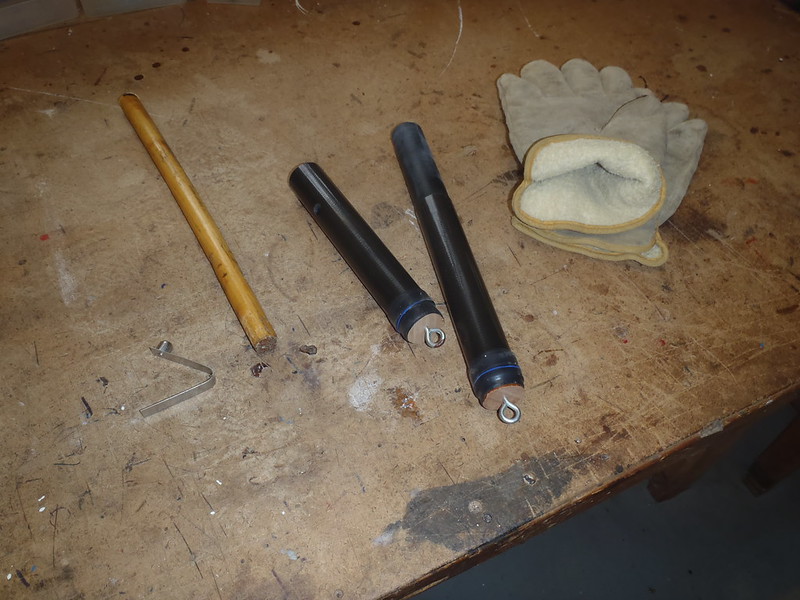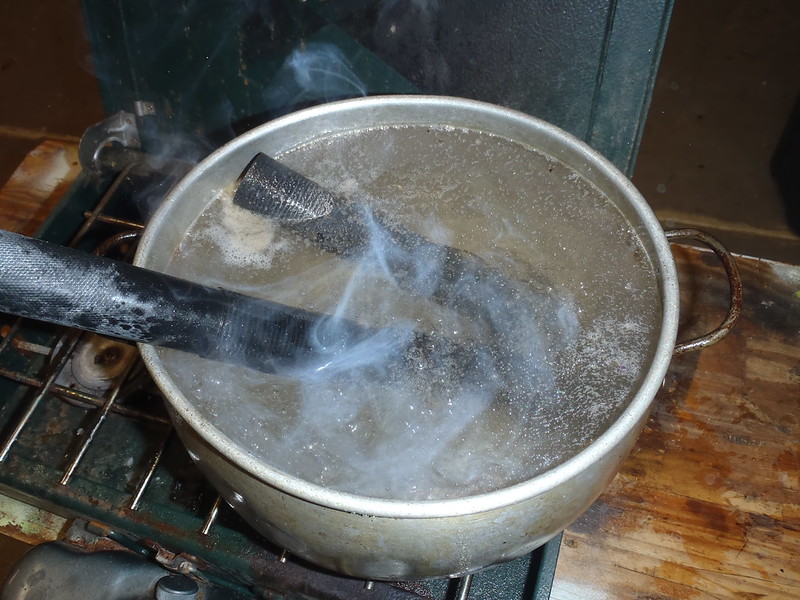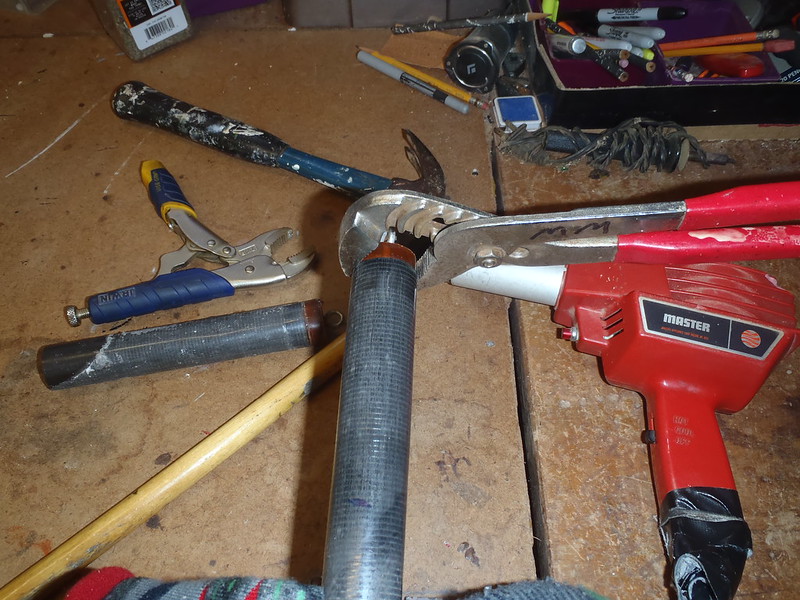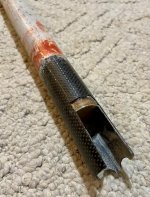What the heck, that ferrule is useless as nunchucks to me as is. If I destroy it in an attempt to unplug the exposed paddle shaft nothing ventured, nothing gained. And I’ll know if it works or not.
Some prep work – there is always prep work – eye screws in the ends for pulling, dowel piece cut for pushing/pounding inside the ferrule, insulated leather gloves so I can handle the boiled object of experiment.
 PC170001
PC170001 by
Mike McCrea, on Flickr
I removed the button clip, it doesn’t need to get boiled. And I didn’t want spaghetti flavored with a hint of old epoxy, so I turned to the battered pot I use for melting Fire-in-a-Can wax. As a preliminary precaution I left the ferrule parts sleeved together. Those pieces are very tightly sleeved, some carbon ferrules come with factory matching ID numbers. If boiling were to misshape the ferrule sleeves, that would be an immediate fail.
First glaring oversight failure.
It is a carbon fiber ferrule with wood inside dumdum. When you try to submerge one end in a pot of water guess what? It
floats! I added a weight to keep the wood shaft end fully submerged.
 PC170004
PC170004 by
Mike McCrea, on Flickr
A half hour later, with a rolling boil, I gave it a try. The wood inside was unbudgable. I let it get to a rolling boil once again, pulling the eye screw while pushing, then tapping, then, screw it, forcefully hammering inside with the dowel rod. Bupkiss; I can at least take satisfaction that, when I sanded the shaft ends to fit snug inside the ferrules and epoxied them I did a helluva fine job.
Continuing attempts. Boiled for nearly an hour, until the Coleman fuel ran low. In case that long-boil worked I took the ferrule apart and submerged both ends. Yum, ferrule soup. Needs salt.
 PC180005
PC180005 by
Mike McCrea, on Flickr
That was another nope. But y’all know how I am, one last try, the stove is out, the pot has water and the shop smells funny (residual wax). I refilled the fuel tank, boiled them for another hour and then let them seep for a spell in the hot water. Another nope.
While they were still saturated hot it was time to try the heat gun. Lots of heat gun action. Pulling on the eye screw while hammering with the push rod, the shaft remnants didn’t budge an iota. I tried grabbing the shaft end with channel locks and tried twisting while the carbon fiber tube was hot. No dice.
 PC190011
PC190011 by
Mike McCrea, on Flickr
I have given up on a heat solution. It seemed like a possibility, considering “
some epoxies can withstand temperature up to 100 ℃ ( 212 ℉), whereas carbon fiber reinforced carbon matrix composite can tolerate temperatures above 2000℃ (3632 ℉)”.
However “
Carbon fibers by themselves have a negative coefficient of thermal expansion (CTE)–meaning that when they are heated, they shrink”.
Eh, having the carbon ferrule tubes shrink tighter around the paddle shaft remnants wasn’t helping my shaft removal cause.
The carbon ferrule reuse idea, and I’m not even sure it is a good one, was to make a take-apart pole, using the 15” long carbon ferrule and two 6’ long sections of wood for easier transport. Duckworks carbon fiber ferrules run $30.
https://duckworks.com/carbon-fiber-double-paddle-ferrules-small/
We have several poles, and I’m not dropping $30 just to see if it works.
A failed experiment is still an experiment, and I learned a few new things about carbon fiber. BTW, even after long boiling the ferrule halves unsleeved they did not warp; they still went back together tight, snug and easy.
I haven’t given up, and may try drilling out as much wood shaft as I can, but I have funner projects to turn to.
 PC120001 by Mike McCrea, on Flickr
PC120001 by Mike McCrea, on Flickr PC120002 by Mike McCrea, on Flickr
PC120002 by Mike McCrea, on Flickr PC120001 by Mike McCrea, on Flickr
PC120001 by Mike McCrea, on Flickr PC120002 by Mike McCrea, on Flickr
PC120002 by Mike McCrea, on Flickr





